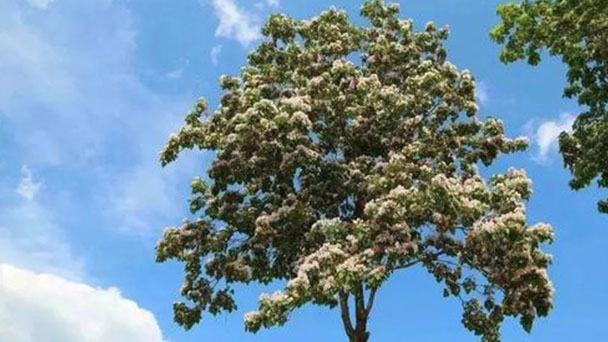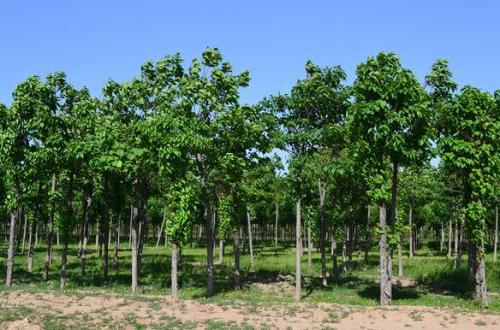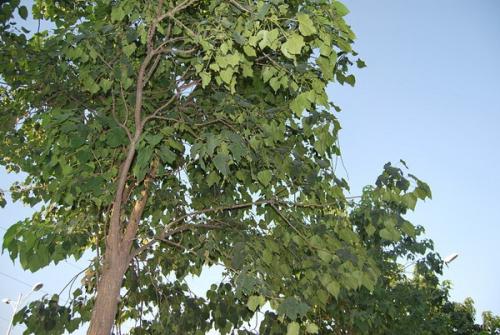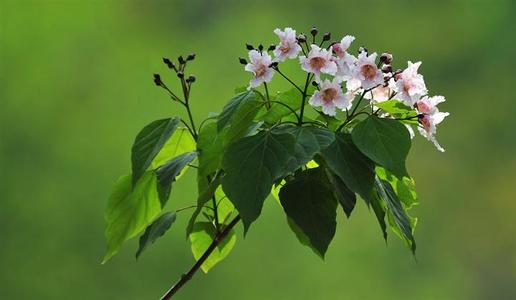Catalpa bungei profile
Written by Maggie
Mar 24 2021

Catalpa Bungei is originally from China. Catalpa Bungei is distributed from the east coast to Gansu province in the west, Yunnan province in the south, and the Great Wall in the north. It can grow well in Liaoning, Inner Mongolia, Xinjiang and other provinces and regions through introduction and cultivation. In the Han Dynasty, people not only cultivated Catalpa Bungei in a large area, but also got rich income from the operation of Catalpa Bungei. People in ancient times also planted Catalpa Bungei as a way to inherit property from their children and grandchildren.
Catalpa Bungei picture

Morphological characteristics of Catalpa Bungei
Catalpa Bungei is a small tree, 8-12 m tall. Leaves are triangular-ovate or ovate-oblong, 6-15 cm long and 8 cm wide, apically acuminate, basally truncate, broadly cuneate or cordate, sometimes with 1-2 teeth at base, dark green, back glabrous;Petiole 2-8 cm long.
Catalpa Bungei terminal corymbose is racemes with 2-12 flowers. Calyx buds are globose, 2 lip dehiscent, apical;2, pointed teeth. The corolla reddish, with 2 yellow stripes and dark purple spots, 3-3.5 cm long.
The capsule is linear, 25-45 cm long, ca. 6 mm wide. Seeds are elongate elliptic, ca. 1 cm long, ca. 2 cm wide, hairs growing on both ends. Flowering period is May to June and fruiting June to October.
Catalpa bungei planting
In winter and spring, planting can be carried out, bud grafting can be carried out from spring to late autumn. In winter, during the idle time of farming, the anvil is dug out and grafted indoors. After grafting, it is stacked neatly indoors or in the kiln, and the wet sand is stored to promote the healing of the interface. In early spring, the planting was transferred to the nursery, the spacing of plants was 1× 0.4 meters, 1500 ~ 2000 plants per mu. Grafting is good before and after Tomb Sweeping Day in spring. In nursery sites, with the stubble, with the graft, with the seal, the graft survival rate was generally about 90%.
Grafting method:
Grafting is based on splitting and bud grafting. The scion was cut at 25px on the bud and 3-125px on the lower part, and the lower part was cut into wedge-shaped buds with the inlet to be connected. Cut 3-125px away from the ground surface of the zi anvil, select the smooth surface and cut 3-125px deep along the pulp center. When pulling out the knife, pinch the scion tightly with thumb and forefinger and insert it into the knife edge. Note the cambium between scion and rootstock. If the rootstock and scion are not tightly clamped, tie the wound with a twine and plastic strip, then seal the wound with wet soil.10 ~ 15 days can be sprouting.The main grafts are embedded grafts.
Landscape value of Catalpa Bungei
Since ancient times, Catalpa Bungei has been widely planted in palace gardens and famous scenic parks. For example, the Imperial Palace in Beijing, Beihai, Summer Palace, Grand Jue Temple and other holy places and famous temples can be seen everywhere. The ancient catalpa bungei has been vigorous and graceful for more than a hundred years. The types of Catalpa Bungei are used for greening, such as Dense ash ash, Ash ash, trifid ash, light leaf ash, etc., or for ornamental gardens with beautiful trees and large flowers; Or leaves are densely hairy, leathery thick branches, conducive to sound insulation, noise reduction, noise prevention, dust retention, this type of leaves, flowers, branches, fruit, bark, crown shape, has a high ornamental value and greening effect.

Medical value of Catalpa Bungei
Catalpa bungei leaves, bark and seeds are all Chinese herbs, which have the effects of astringency and hemostasis, clearing damp and pain relief. Seeds containing citric acid and alkaline salts, is the treatment of kidney disease, wet peritonitis, swollen beriberi medicine. Root, skin boil soup juice, external smear wash treatment fistula sore and all swollen poison.
The leaves of Catalpa are rich in nutrients. The young leaves can be eaten, and the flowers can be fried or refined into aromatic oil. In bo Lu of Wild vegetables written by Bao Shan in Ming Dynasty, it is recorded that the food method, the flowers are fried and cooked, and the oil and salt are mixed. Also Catalpa Bungei can be used as feed.
The ecological value of Catalpa Bungei
Catalpa Bungei is a deep-rooted tree with well-developed roots. Five year old Catalpa Bungei is 6.8 meters high, 10 cm in DBH, 90 cm deep in taprots, and 1.3×1.5 m in root width. More than mulberry, acacia, tamarix, Chinese toon, white wax tree species. Therefore, it is a good tree for protecting farmland, railway, highway, ditch and river. In addition, Catalpa Bungei has a dense canopy, strong resistance to toxic gases such as sulfur dioxide and chlorine, and can purify the air, making it an excellent tree for greening cities and improving the environment. A strong ability to silence noise, dust, drug abuse. Catalpa Bungei is widely planted in villages, factories, mines, houses and roadsides to purify air and reduce noise. Catalpa Bungei is a deep-rooted tree with well-developed roots. It plays a very good role in preventing soil erosion, arresting wind erosion, fixing sand dunes and protecting farmland.
More than 80% of the roots of Catalpa Bungei are concentrated in the soil layer below 40cm of the ground surface. There are few fibrous roots in the surface tillage layer, which are basically staggered with the roots of crops and will not compete for water and fertilizer with crops. It is one of the lightest tree species in threatened land and the most ideal tree species for protection of farmland forest networks. Catalpa Bungei is also resistant to water and humidity. Tests show that it can withstand water logging for about 20 days, and can withstand water for 10-15 days, and still grow normally. Therefore, Catalpa Bungei is a good species for retaining banks.

Latest Updated
- Benefits of Bugleweed - 7 Science-backed Health Benefits
- Bugleweed Dangers & Side Effects - Is It Poisonous?
- How to Plant Evergreen Trees - What You Should Know
- When to Plant Evergreens - Grow Guide for Evergreen Trees
- 12 Wonderful Evergreen Shrubs for Your Garden
- 12 Popular Evergreen Plants with Pictures for Beginners
- When And How To Prune A Lilac Bush Like a Pro
- How to Grow & Care for Lilac Vine (Hardenbergia Violacea)
- Japanese Lilac Tree (Syringa Reticulata) Care & Propagation Guide
- Shumard Oak Pros and Cons - What to Know
Popular Articles
- Winter maintenance of Antirrhinum Majus
- How to Grow Terminalia Mantaly Tree
- How to Grow and Care for Crossostephium Chinense
- How to grow Antirrhinum Majus in spring
- Peristeria Elata (Dove Orchid) Profile: Info & Care Guide
- Underwatered Snake Plant (Sansevieria Trifasciata) - Signs And How To Fix
- How to Care for Brazilian Jasmine Plant (Mandevilla Sanderi)
- How to Grow & Care for Graptopetalum Purple Delight in Summer
- Rosa Chinensis (China Rose): Plant Growing & Care Tips
- How to Care for Baby Sun Rose (Aptenia Cordifolia)